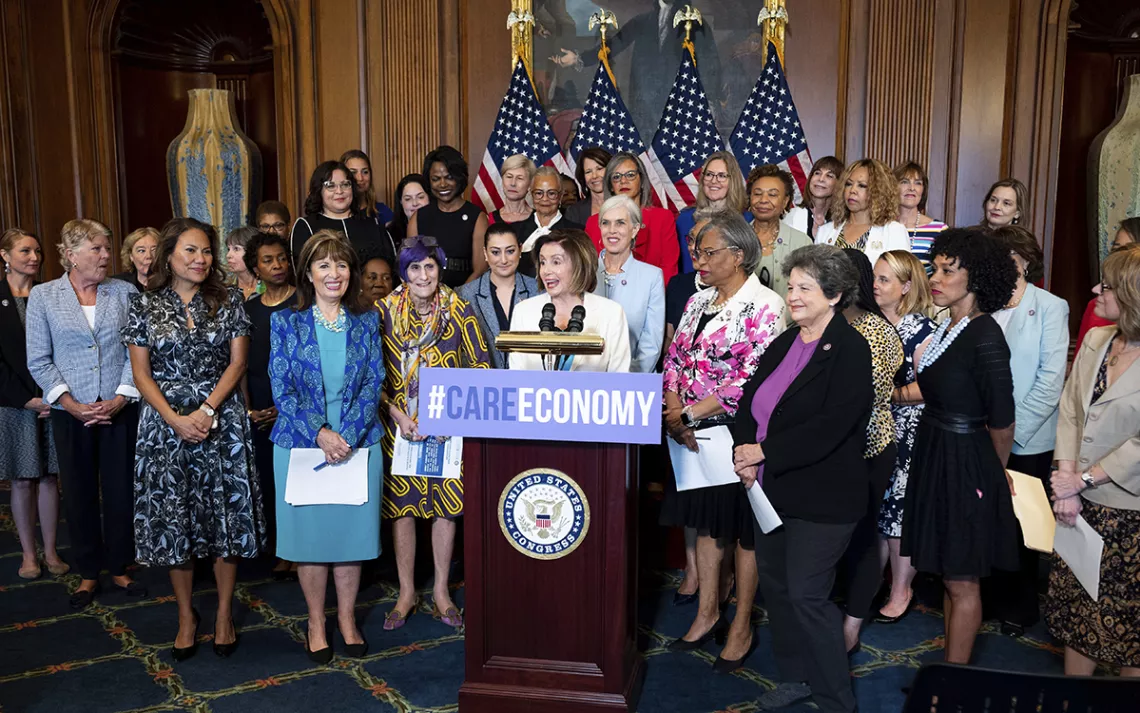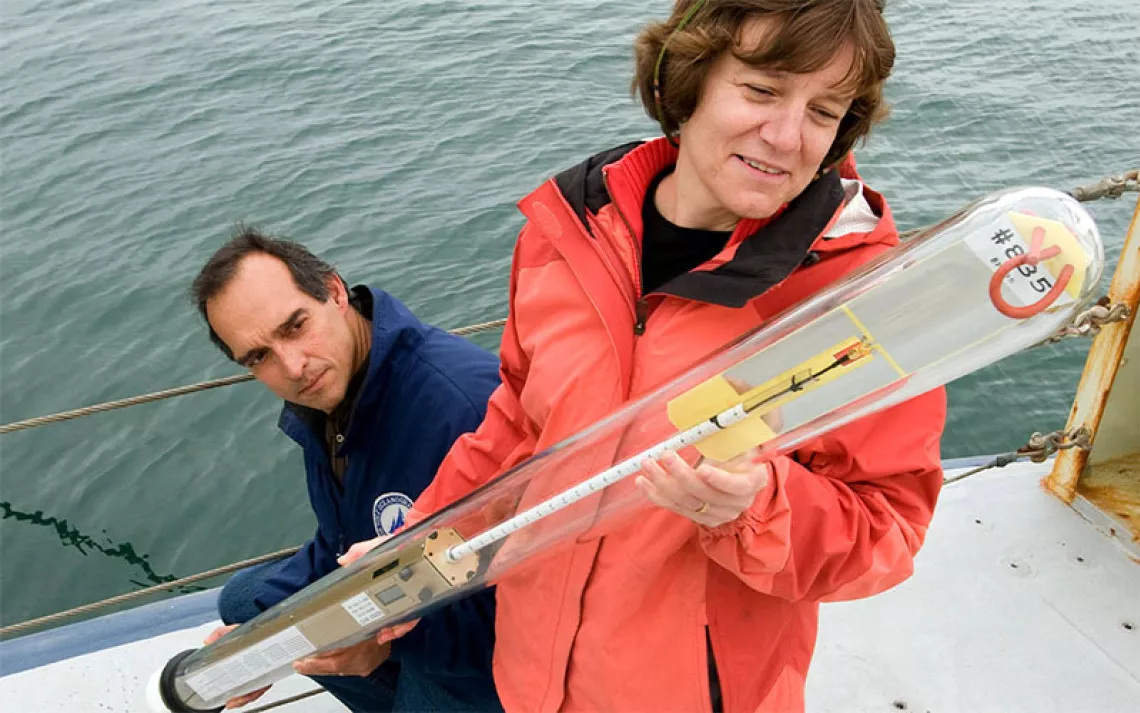When Women Lead, the Environment Benefits
What’s behind the correlation between gender and a commitment to environmental protection?

House Speaker Nancy Pelosi speaking at a Democratic Women’s Caucus press conference on the care economy. Photo by Michael Brochstein/Sipa USA via AP Images
In case you haven’t noticed, there are some kick-ass women running for office this year. Take Vermont state senator Kesha Ram Hinsdale, who wrote the state’s first environmental justice bill. If she wins her bid for the US House of Representatives, she’ll be the first woman of color to represent Vermont. Or look at Cheri Beasley, the first Black woman to serve as Chief Justice of the North Carolina Supreme Court, now running for a seat in the US Senate.
Beasley is one of the women of color running for US House and Senate seats being supported through the LCV Victory Fund. “We’re getting involved in these primaries because electing more pro-environment women of color is good for people and the planet – we desperately need Congress to be more representative of the electorate,” said Megan Jacobs, LCV Victory Fund senior national campaigns director, in a press release. “With increasing climate-fueled extreme weather events and rising energy prices, it is more important than ever to send strong climate leaders to Congress who support investing in clean energy, advancing environmental justice, and lowering costs for families.”
If we want to make progress on protecting the environment and public health, we should help elect more women to public office, and support them during their tenure, argues Rachel’s Action Network, a nonprofit dedicated to empowering pro-environment women to take political action.
According to the most recent iteration of the organization’s long-running report, When Women Lead, women in Congress consistently vote for pro-environment legislation more often than their male counterparts. There are more women serving in the 117th Congress than ever before. Yet just 28 percent of US Representatives and 24 percent of US Senators are women. The disparity holds for state and municipal offices, though it varies from state to state. Greater gender parity, the report argues, should lead to stronger environmental protection and long overdue climate legislation.
When Women Lead relies on the environmental scorecards tallied by the League of Conservation Voters, or LCV, which the group has been keeping since 1972. A cursory look at the LCV scorecards reveals not just a gender divide when it comes to environmental legislation, but a growing partisan chasm. Overall, Democrats are trending upward when it comes to environmental voting, while Republicans are taking a collective plunge into dismal territory. In recent years, the gaps between Democratic men and Democratic women have been closing. Meanwhile, Republican women’s environmental voting records are now just marginally better than Republican men’s.
Clearly, simply being a woman doesn’t make you more likely to vote for stronger environmental protections. Anyone who paid attention to the 2008 election will forever hear Sarah Palin’s “Drill, baby, drill,” echoing in their brains. Arguably, Senator Kristen Sinema of Arizona, who has the second lowest lifetime LCV score of any current Democratic senator, is just as responsible for blocking President Biden’s climate legislation as Joe Manchin. As for the Republicans, you only have to consider Marjorie Taylor Greene—who has an LCV score of 0% and who infamously suggested that “space solar generators” may have been responsible for California’s catastrophic wildfires—to understand that gender doesn’t determine environmental commitment.
The polarization of environmental scores among Congressional representatives can be explained in part by our “first past the post” electoral system, says Amy Atchison, Professor of Political Science and International Relations at Middle Tennessee State University.
Candidates are being selected by a “ridiculous” minority of the voting age population, Atchison says. Especially in a highly gerrymandered system in which districts are drawn to protect the interests of the political parties, the primaries are where it’s at. Yet hardly anyone votes in these elections, especially during the midterms. According to Pew Research Center, just over 19 percent of registered voters cast ballots in primary elections for the US House in 2018—and that was several percentage points higher than the 2014 midterms.
The voters who do turn out, notes Atchison, are the most ideologically committed. Increasingly, this translates into more extremist candidates, especially on the Republican side—since political polarization has been more intense among conservatives.
Erica Flock, communications and advocacy director for Rachel’s Action Network, agrees that party is the most salient indicator when it comes to how lawmakers votes. But, she argues, if you look at the proportion of women in Congress by party, Democratic women outnumber Republican women by two to one in the Senate and three to one in the House.
“Perhaps women [candidates] are more drawn to the party that supports environmental protection,” Flock says. Or perhaps, pointing to the improved environmental scores among all Congressional Democrats, “women have pushed the party to support environmental issues more strongly.”
Flock admits these are speculations. But there is compelling evidence that having more women in high office leads to stronger environmental policies. In 2019, in an analysis of 18 Western parliamentary democracies, Atchison and co-author Ian Down showed that parliaments and cabinets with more women also had higher environmental standards. Women MPs were also more willing to meet with representatives from environmental organizations than men. Another study from that same year, which looked at the attitudes and voting behavior of European members of parliament, showed that even though men and women expressed equal levels of concern about environmental issues, when it came time to actually put their beliefs into practice, women were more likely to vote for strong environmental legislation.
Atchison cautions that if our primary goal is gender parity, we’d better prepare for more right-wing candidates alongside progressive ones. “If you increase the share of right-wing parties that don’t believe climate change is real, you probably won’t close the environment gap,” Atchison says. “If your goal is more feminist policy, you need more feminist legislators, whether they’re male or female.”
While many US progressives are wringing their hands over this year’s midterm elections, there are plenty of progressive candidates to get excited about.
Rachel’s Action Network has endorsed several candidates this year, focusing on women running for federal or state offices in competitive races who have earned endorsements from major environmental groups..
Mũthoni Wambu Krall, a long-time political strategist, sees an opportunity for progressive women of color to advance climate legislation. “I think these diverse women who are also climate champions matter a lot for environmental justice work,” she says, adding that climate has become one of the top three issues for her clients. The “EJ side” of environmental legislation has been “extraordinarily neglected” by lawmakers, Wambu Krall says. “If it hasn’t touched your family or community, it’s hard to adopt as one of your top issues.”
Here, women of color are uniquely positioned. Environmental justice communities are often composed of racial and ethnic minorities; these communities are also more vulnerable to the effects of climate change. Often, women rise to become leaders in these communities so they can help address inequalities and threats to health and safety.
Wambu Krall founded her firm, Dunia Political Impact, so she could support progressive candidates. These include Beasley, North Carolina’s Chief Justice, and Kesha Ram Hinsdale, a Vermont state senator running for the US House.
Selecting candidates who understand how the legislative process works and how to build bridges is vital, says Wambu Krall. “They know what stone walls they will face and will come in with strategic expertise to advance certain pieces of legislation,” she explains. “That’s something that’s often neglected when we look at the resumes of candidates.”
From the leaked Supreme Court opinion on Roe v Wade to the failure of Build Back Better, ,it’s all too clear that both women’s equality and meaningful action on climate change remain elusive.
But just as a solid majority of Americans believe women should have the right to choose a safe, legal abortion over an unwanted pregnancy, a majority of Americans also want the federal government to do more to combat climate change. It’s up to us to elect people who have the guts to legislate policy that will better represent our wishes. And, as the record shows, more often than not, that person is going to be a woman.
This article is funded by the Sierra Club Voter Education Fund, which seeks to raise key environmental issues in the discussions around elections and encourage the public to find out more about candidates’ positions on key environmental issues.
 The Magazine of The Sierra Club
The Magazine of The Sierra Club



